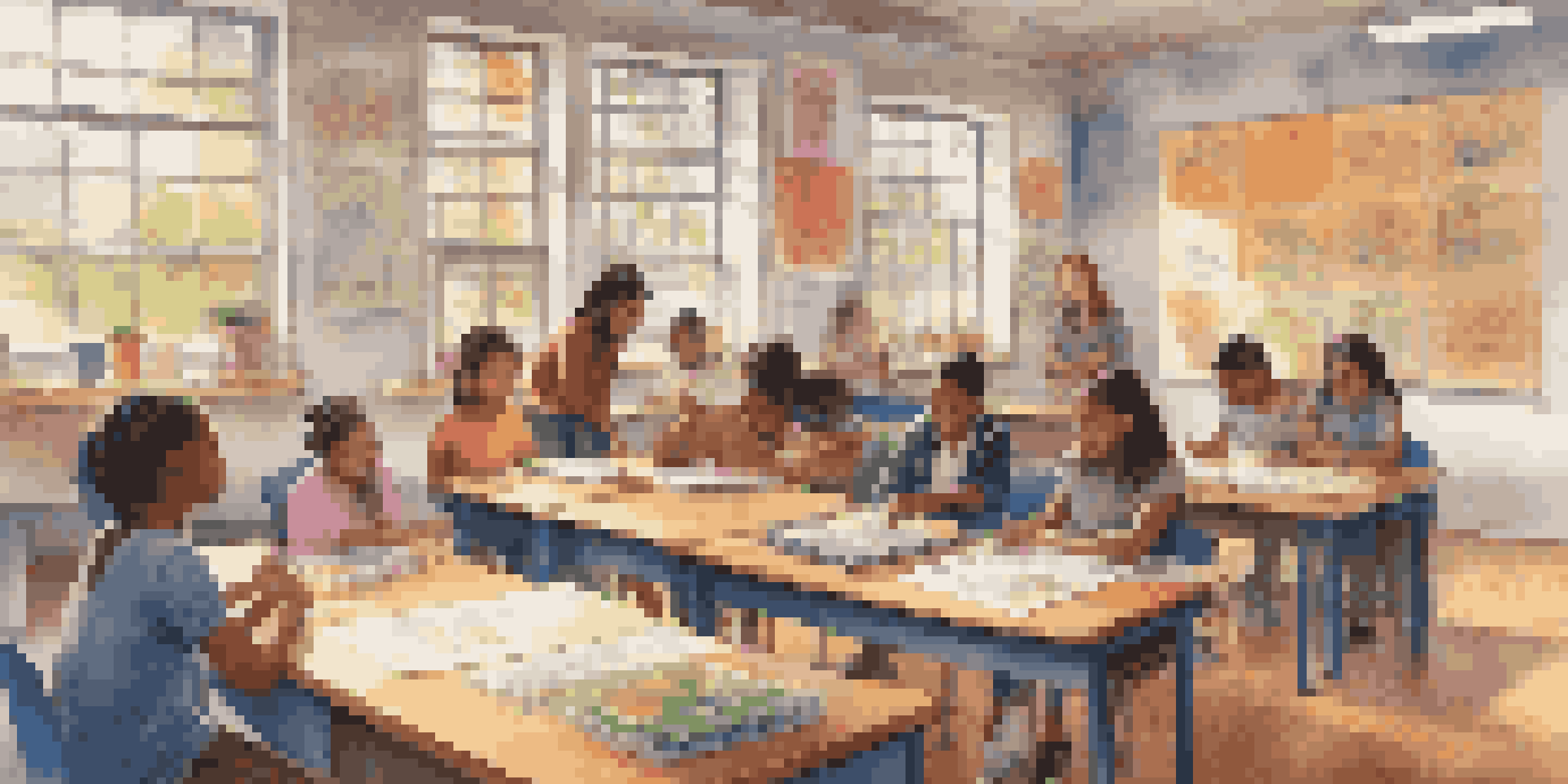Engaging Diverse Learners Through Interdisciplinary Methods

Understanding Diverse Learners in Education Today
In today's classrooms, diversity is more than just a buzzword; it's a reality. Learners come from various backgrounds, cultures, and learning styles, each bringing unique strengths and challenges. Understanding these differences is crucial for educators who aim to foster an inclusive environment where everyone can thrive.
Diversity is not a reason for division, but a reason for enrichment.
For instance, consider a classroom with students who have different language proficiencies. Some may be native speakers, while others could be learning English as a second language. By recognizing these differences, teachers can adapt their methods to ensure that all students feel valued and are able to participate fully.
Embracing diversity not only enriches the learning experience but also prepares students for a globalized world. When educators acknowledge and celebrate the various perspectives that each learner brings, it creates a more dynamic and engaging classroom atmosphere.
The Power of Interdisciplinary Learning
Interdisciplinary learning combines multiple subjects, allowing students to make connections between ideas and apply knowledge in real-world contexts. This approach encourages learners to think critically and creatively, which is essential for tackling complex problems. For example, a project that integrates science, art, and history can help students understand the impact of climate change through various lenses.

When students engage in interdisciplinary methods, they often become more motivated and invested in their learning. By seeing how different subjects interrelate, they can grasp the relevance of their education to their lives and future careers. This holistic approach not only enhances retention but also encourages deeper understanding.
Embrace Diversity for Inclusion
Understanding diverse learners is essential for creating an inclusive classroom environment where all students can thrive.
Moreover, interdisciplinary learning fosters collaboration among students. Working in groups on projects that span multiple disciplines encourages them to communicate effectively and appreciate diverse viewpoints, skills that are invaluable in any career.
Strategies for Implementing Interdisciplinary Methods
To effectively engage diverse learners, educators can employ various strategies when implementing interdisciplinary methods. One effective strategy is to design thematic units that revolve around a central topic—like sustainability—drawing from science, social studies, and even art. This allows students to explore the topic from various angles, making the learning experience more engaging.
The more we embrace diversity, the more we learn from one another.
Another strategy is to integrate technology into lessons, using tools like virtual field trips or collaborative platforms. For example, students can research environmental issues online and present their findings through multimedia projects. This not only makes learning interactive but also appeals to different learning styles.
Lastly, it's essential to incorporate student voice and choice into interdisciplinary projects. Allowing students to choose their topics or the format of their presentations can enhance their engagement and ownership of the learning process, ensuring that diverse interests and abilities are taken into account.
Creating a Supportive Learning Environment
A supportive learning environment is foundational for engaging diverse learners. This includes fostering a classroom culture where every student feels safe to express their ideas and take risks. Teachers can achieve this by setting clear expectations and encouraging respectful dialogue among peers, allowing students to learn from one another.
Additionally, providing differentiated instruction is key to meeting the varied needs of students. This might involve offering different levels of tasks or providing additional resources for students who need extra support. By tailoring instruction to individual needs, educators can ensure that all learners are challenged and supported.
Interdisciplinary Learning Benefits
Integrating multiple subjects enhances critical thinking and real-world application, making education more relevant and engaging.
Finally, building strong relationships with students is vital. When students feel connected to their teachers and peers, they are more likely to be engaged and motivated. Taking the time to learn about students’ interests and backgrounds can go a long way in creating a positive and inclusive classroom atmosphere.
Incorporating Culturally Relevant Pedagogy
Culturally relevant pedagogy recognizes the importance of including students' cultural references in learning. This approach not only validates students' identities but also enhances their engagement. For instance, using literature from diverse authors can enrich discussions and provide relatable contexts for students to explore complex themes.
Moreover, culturally relevant teaching encourages students to connect their own experiences with academic content, making learning more meaningful. By discussing real-world issues that resonate with students' lives, educators can spark interest and foster critical thinking skills.
Ultimately, when students see their cultures represented in the curriculum, they are more likely to feel a sense of belonging. This inclusivity can lead to improved academic performance and a greater appreciation for diversity within the classroom.
Assessing Progress in Diverse Learners
Assessing the progress of diverse learners can be challenging, especially within interdisciplinary contexts. Traditional testing methods may not adequately reflect students' understanding or skills. Therefore, educators should consider alternative assessment strategies, such as portfolios, presentations, or group projects, which allow for a broader demonstration of knowledge.
Additionally, formative assessments can provide valuable insights into students' learning processes. By implementing regular check-ins or interactive quizzes, teachers can gauge understanding and adjust instruction as needed. This ongoing feedback loop helps ensure that all students are on track to meet their learning goals.
Culturally Relevant Pedagogy Matters
Incorporating students' cultural references in teaching fosters engagement and a sense of belonging, improving academic performance.
Moreover, involving students in the assessment process empowers them to take ownership of their learning. By encouraging self-assessment and peer assessment, educators can foster a growth mindset, where students recognize their progress and areas for improvement.
The Future of Education: Embracing Diversity and Interdisciplinary Methods
As the educational landscape continues to evolve, embracing diversity and interdisciplinary methods will be crucial for preparing students for the future. The world is becoming more interconnected, and the ability to think critically across disciplines will be essential in addressing global challenges. Educators who adapt their teaching practices to meet the needs of diverse learners will cultivate a generation of innovative thinkers.
Looking ahead, technology will play a significant role in facilitating interdisciplinary learning. Online platforms, digital resources, and virtual collaborations can connect students with experts and peers worldwide, enriching their educational experiences. This expansion of learning opportunities can help bridge gaps and promote equity in education.

Ultimately, the goal of engaging diverse learners through interdisciplinary methods is to create an inclusive and dynamic educational experience. By prioritizing these approaches, educators can inspire students to become not only knowledgeable individuals but also empathetic and proactive members of society.